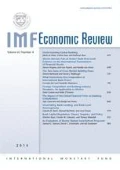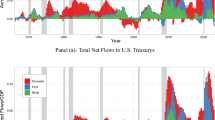Abstract
We estimate the value creation for the stocks purchased by the Chinese government between the period starting with the market crash in mid-June of 2015 and the market recovery in September. We find that the government intervention increased the value of the rescued non-financial firms by RMB 206 billion after netting out the average purchase cost, which is about 1% of the Chinese GDP in 2014. The short-term value creation came from the increased stock demand, the reduced default probabilities, and the increased liquidity. The intervention may come at a long-run cost of creating moral hazard, preventing price discovery, creating more uncertainty, and damaging government credibility.


Similar content being viewed by others
Notes
Based on the exchange rate on June 30, 2015 (RMB 6.11 per US dollar), the loss is roughly 3 trillion US dollars.
The CSF was established in 2011 to lend to securities brokerages to support margin lending to stock investors.
The CCH is a wholly owned subsidiary of China Investment Corporation, with its own board of directors and board of supervisors. It is an organization by which the Chinese government can act as a shareholder for the big four state-owned banks and some other banks.
See Allen et al. (2015) for a study on the disconnection between China’s economic growth and the stock market performance.
See Acharya et al. (2016) for a study on the wealth management products in China.
Under the CSRC regulations, any listed stock must be traded at prices within a lower limit and an upper limit in any trading day. The lower (upper) limit is the price level 10% below (above) the close price in the previous trading day.
There are other investment vehicles funded by the China Securities Finance Corporation, a stock market stabilization fund, as well as the Wutongshu investment platform, the equity fund owned by the central bank of China. We did not include stocks purchased by those investment vehicles and shadow funds due to data limitations. Therefore, the purchased stocks included in our sample might underestimate the total amount of the rescue plan.
Financial firms have totally different balance sheets and profit sources compared with non-financial firms. Taking banks as an example, a majority of assets of banks are the loans lent to non-financial firms.
The result is available upon request.
References
Acharya, Viral V., Qian Jun, and Zhishu Yang. 2016. In the Shadow of Banks: Wealth Management Products and Bank Risks. Working Paper, SAIF.
Allen, Franklin, Susan C. Shan, Jun Qian, Julie L. Zhu. 2015. Explaining the Disconnection Between China’s Economic Growth and Stock Market Performance. Working Paper, SAIF.
Amihud, Yakov. 2002. Illiquidity and Stock Returns: Cross-Section and Time-Series Effects. Journal of Financial Markets 5: 31–56.
Bacchetta, Philippe, Tille Cedric, and Eric van Wincoop. 2012. Self-Fulfilling Risk Panics. American Economic Review 102 (7): 3674–3700.
Benhabib, Jess, Xuewen Liu, and Pengfei Wang. 2015. Sentiments, Financial Markets, and Macroeconomic Fluctuations. Journal of Financial Economics 120 (2): 420–443.
Bharath, Sreedhar, and Shumway Tyler. 2008. Forecasting Default with the Merton Distance to Default Model. Review of Financial Studies 21: 1339–1369.
Bian, Jiangze, Zhi Da, Dong Lou, and Hao Zhou. 2017a. Leverage Network and Market Contagion. Working Paper, Tsinghua University.
Bian, Jiangze, Zhiguo He, Kelly Shue, and Hao Zhou. 2017b. Leverage-Induced Fire Sales and Stock Market Crashes. Working Paper, University of Chicago.
Brogaard, Jonathan, Dan Li, and Ying Xia. 2016. Stock Liquidity and Default Risk. Journal of Financial Economics 124: 486–502
Brunnermeier, Markus, and Pedersen Lasse. 2009. Market Liquidity and Funding Liquidity. Review of Financial Studies 22: 2201–2238.
Chen, Hui, Anton Petukhov, and Jiang Wang. 2016. A Dynamic Model of Circuit Breakers. Working Paper, MIT.
Chen, Ting, Gao Zhenyu, He Jibao, Jiang Wenxi, Xiong Wei. 2017. Daily Price Limits and Destructive Market Behavior. NBER Working Paper.
Chen, Zhuo, He Zhiguo, and Liu Chun. 2017. The Financing of Local Government in China: Stimulus Loan Wanes and Shadow Banking Waxes. Working Paper, University of Chicago.
Cheng, L.T.W., J.K.W. Fung, and K.C. Chan. 2000. Pricing Dynamics of Index Options and Index Futures in Hong Kong Before and During the Asian Financial Crisis. Journal of Futures Markets 20: 145–166.
Chi, Yegang, and Xiaoming Li. 2017. Beauties of the Emperor: Investigations of an Opaque Stock Market Bailout. Working Paper, Shanghai Jiaotong University.
Crosbie, Peter, and Jeffrey Bohn. 2003. Modeling default risk. KMV white paper series.
Huang, Yi, Marco Pagano, and Ugo Panizza. 2016. Local Crowding Out in China. Working Paper, Graduate Institute, Geneva.
Liu, Xiaolei, Jiajie Xu, and Ninghua Zhong. 2017. Trading Restrictions as a Channel of Financial Contagion: Evidence From China’s Stock Market. Working Paper, Beijing University.
Merton, Robert. 1974. On the Pricing of Corporate Debt: The Risk Structure of Interest Rates. Journal of Finance 29: 449–470.
Miao, Jianjun, and Pengfei Wang. 2012. Bubbles and Total Factor Productivity. American Economic Review 102: 82–87.
Miao, Jianjun, and Pengfei Wang. 2014. Sectoral Bubbles, Misallocation, and Endogenous Growth. Journal of Mathematical Economics 53: 153–163.
Miao, Jianjun, and Pengfei Wang. 2015. Banking Bubbles and Financial Crises. Journal of Economic Theory 157: 763–792.
Miao, Jianjun, and Pengfei Wang. 2018. Asset Bubbles and Credit Constraints. American Economic Review 108: 2590–2628.
Miao, Jianjun, Pengfei Wang, and Xu Zhiwei. 2015. A Bayesian DSGE Model of Stock Market Bubbles and Business Cycles. Quantitative Economics 6: 599–635.
Miao, Jianjun, Pengfei Wang, and Jing Zhou. 2015. Asset Bubbles, Collateral, and Policy Analysis. Journal of Monetary Economics 76: S57–S70.
Morck, Randall, Andrei Shleifer, and Robert W Vishny. 1988. Management Ownership and Market Valuation: An Empirical Analysis. Journal of Financial Economics 20: 293–315.
Sharpe, F.William. 1964. Capital Asset Prices: A Theory of Market Equilibrium Under Conditions of Risk. Journal of Finance 19: 425–442.
Song, Zheng, and Wei Xiong. 2018. Risks in China’s Financial System. Annual Review of Financial Economics 10: 261–286.
Su, Yuli, Yewmun Yip, and Rickie Wong. 2002. The Impact of Government Intervention on Stock Returns: Evidence From Hong Kong. International Review of Economics and Finance 11: 277–297.
Vassalou, Maria, and Yuhang Xing. 2004. Default Risk in Equity Returns. Journal of Finance 59: 831–868.
Veronesi, Pietro, and Luigi Zingales. 2010. Paulson’s Gift. Journal of Financial Economics 3: 339–368.
Author information
Authors and Affiliations
Corresponding author
Additional information
Publisher's Note
Springer Nature remains neutral with regard to jurisdictional claims in published maps and institutional affiliations.
Electronic supplementary material
Below is the link to the electronic supplementary material.




